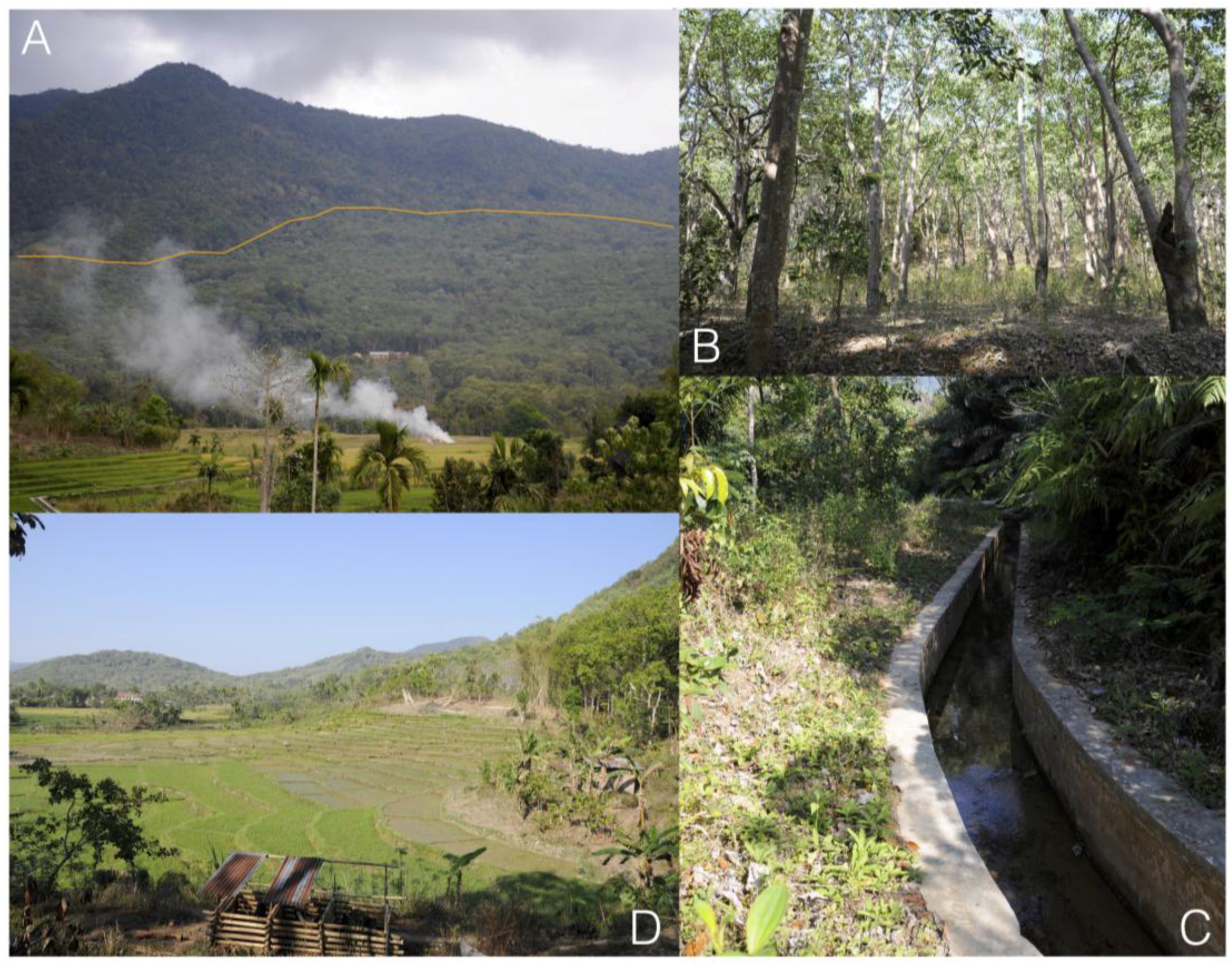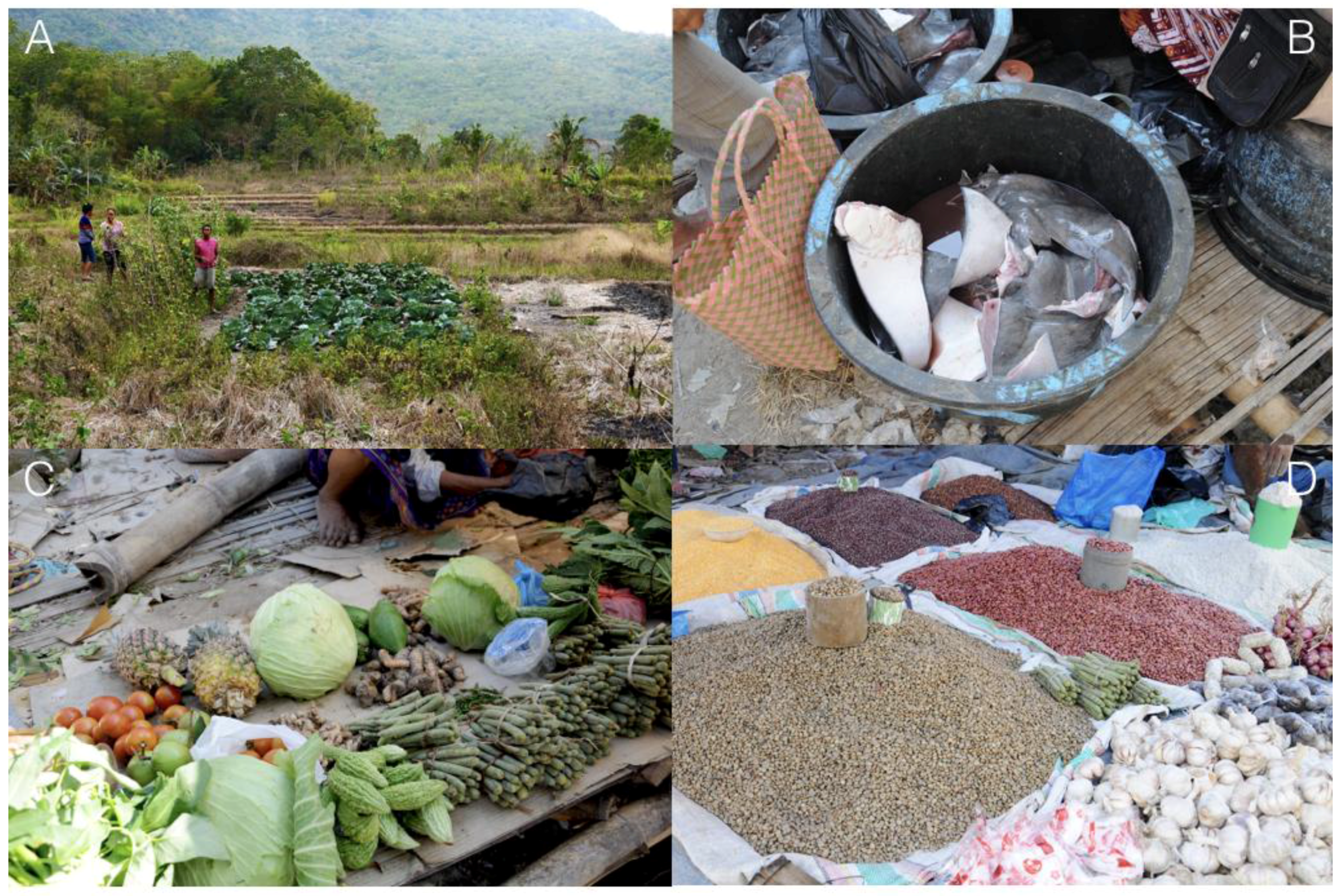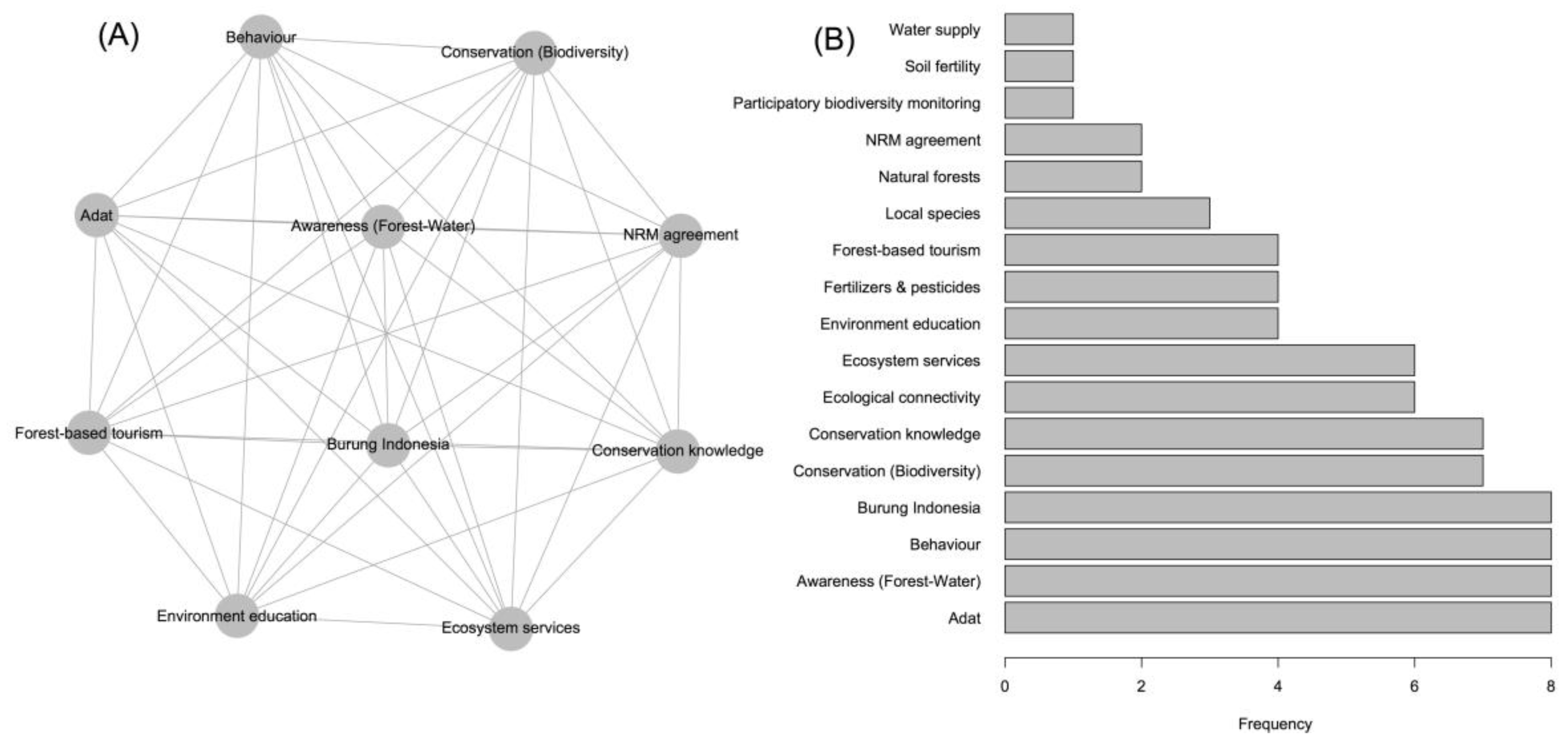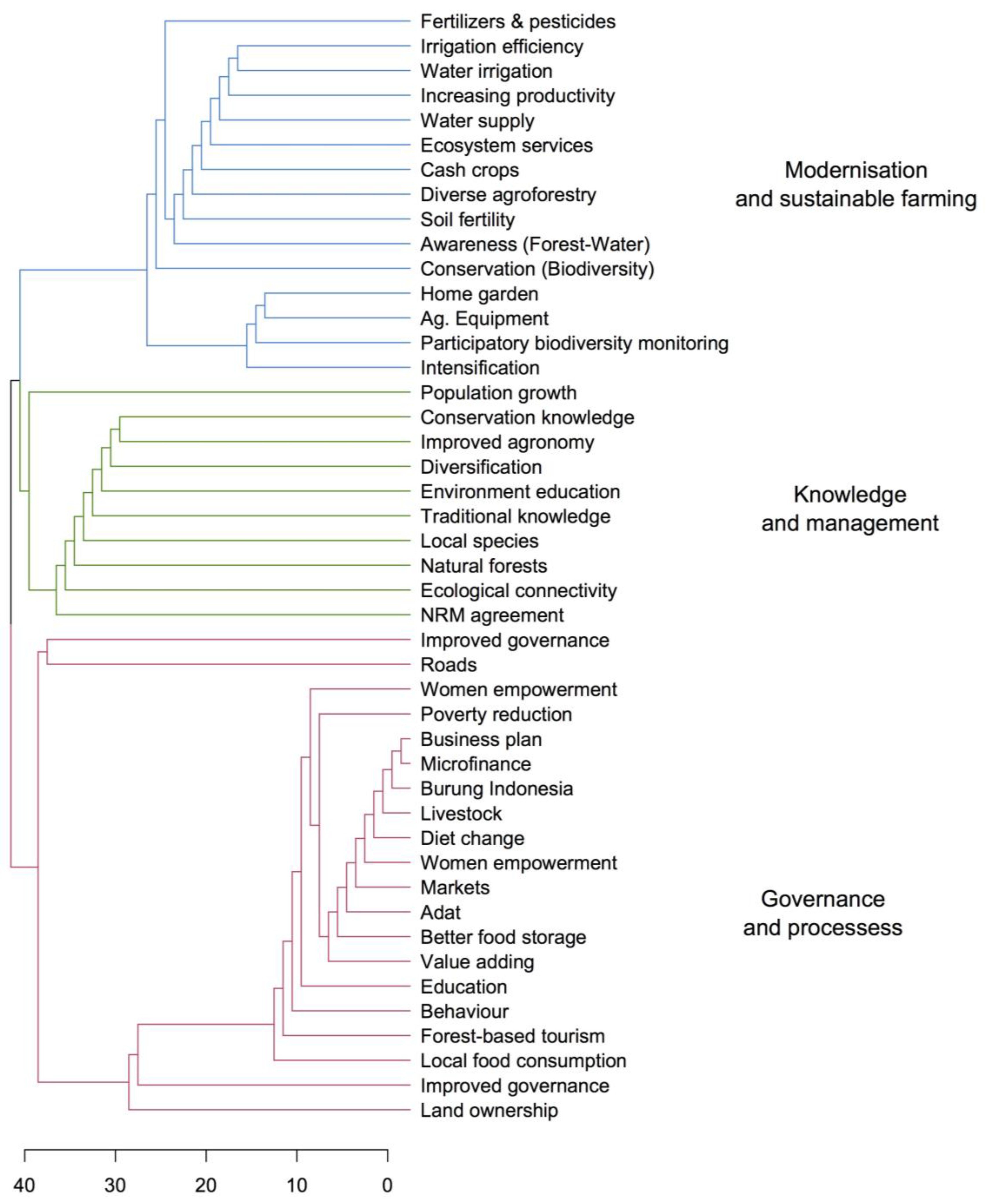System Properties Determine Food Security and Biodiversity Outcomes at Landscape Scale: A Case Study from West Flores, Indonesia
Abstract
:1. Introduction
2. Materials and Methods
2.1. The Landscape
2.2. Cognitive Mapping Workshop and Data Collection
2.2.1. Step I: Identify
2.2.2. Step II: Connect
2.2.3. Step III: Reflect
2.3. Analysis: Network Properties and Social-Ecological System Characteristics
2.4. Cluster Detection
2.5. Graph Narratives
3. Results and Discussion
3.1. Observations of the Landscape
3.2. Network Properties
3.3. Rank Importance of Nodes
3.4. Clusters and System Properties
3.4.1. Cluster 1: Modernisation and Sustainable Farming
- Physical inputs (capital) for agricultural production and livelihoods: water, fertilizer, pesticides, agricultural equipment.
- Natural capital that underpins production: ecosystem services, soil fertility, biodiversity.
- Human capital (implicit) that facilitates better production while managing (minimizing) further environmental impact.
3.4.2. Cluster 2: Knowledge and Management
3.4.3. Cluster 3: Governance and Processes
3.5. Implications and Future Priorities
4. Conclusions
Acknowledgments
Author Contributions
Conflicts of Interest
Nomenclature
| Node | A node is one of two basic building blocks of networks, the other being an edge. Nodes ‘element’ in a network and can represent anything: physical objects, ideas, processes. A node can be connected to one or more other nodes, or it can be isolated from all other nodes in the network. |
| Edge | A connection between two nodes in a network. |
| Component | One or more nodes connected to each other but not connected to one or more other components. An isolated sub-group of one or more connected nodes. |
| Community | A group of nodes in a network that are more connected to each other than to other nodes, or communities of nodes, in the network. |
| Network | A set of nodes and edges defined as G = (V, E) where G is the network or graph, V are the nodes or vertices, and E are the set of edges joining nodes within the network. |
| Clique | A clique is a subgraph of a larger graph (G). A maximal clique is a clique that cannot be extended by including adjacent nodes [47]. |
| System properties | A set of one or more nodes of a system that affect its dynamics and performance. System properties, their interactions with each other, and their magnitude can affect the performance of the system. |
Appendix A
| Common Name | Scientific Name |
|---|---|
| Soursop | Annona muricata |
| Star apple | Chrysophyllum cainito |
| Rambutan | Nephelium lappaceum |
| Langan | Dimocarpus longan |
| Cucumber | Momordica charantia |
| Ferns | Unknown |
| Cocao | Theobroma cacao |
| Papaya | Carica papaya |
| Rice | Oryza |
| Mango | Mangifera |
| Tomato | Solanum |
| Chilli | Capsicum |
| Coffee | Coffea arabica |
| Cloves | Syzygium aromaticum |
| Sweet potato | Ipomoea batatas |
| ‘Hairy’ yam | Dioscorea |
| Pumpkin | Cucurbita |
| Cabbage | Brassica oleracea |
| Candle nut | Aleurites moluccana |
| Mahogany | Swietenia macrophylla |
| Banana | Musa |
| Carrot | Daucus carota |
| Casava | Manihot esculenta |
| ‘Green’ banana | Musa |
| Taro | Colocasia |
| Broccoli | Brassica oleracea |
| Spinach | Spinacia |
| Pineapple | Ananas comosus |
| Coconut | Cocos nucifera |
| Wombok | Brassica rapa |
| Snake bean | Vigna unguiculata |
| Cashew | Anacardium occidentale |
References
- United Nations Sustainable Development Goals. Available online: http://www.un.org/sustainabledevelopment/sustainable-development-goals/ (accessed on 1 January 2016).
- United Nations Strategic Plan for Biodiversity 2011–2020, Including Aichi Biodiversity Targets. Available online: https://www.cbd.int/sp/targets/ (accessed on 1 January 2016).
- Fischer, J.; Brosi, B.; Daily, G.C.; Ehrlich, P.R.; Goldman, R.; Goldstein, J.; Lindenmayer, D.B.; Manning, A.D.; Mooney, H.A.; Pejchar, L.; et al. Should agricultural policies encourage land sparing or wildlife-friendly farming? Front. Ecol. Environ. 2008. [Google Scholar] [CrossRef]
- Fischer, J.; Abson, D.J.; Bergsten, A.; French Collier, N.; Dorresteijn, I.; Hanspach, J.; Hylander, K.; Schultner, J.; Senbeta, F. Reframing the Food-Biodiversity Challenge. Trends Ecol. Evol. 2017, 32, 335–345. [Google Scholar] [CrossRef] [PubMed]
- Perfecto, I.; Vandermeer, J. The agroecological matrix as alternative to the land-sparing/agriculture intensification model. Proc. Natl. Acad. Sci. USA 2010, 107, 5786–5791. [Google Scholar] [CrossRef] [PubMed]
- Chappell, M.J.; LaValle, L.A. Food security and biodiversity: Can we have both? An agroecological analysis. Agric. Hum. Values 2011, 28, 3–26. [Google Scholar] [CrossRef]
- Phalan, B.; Onial, M.; Balmford, A.; Green, R.E. Reconciling food production and biodiversity conservation: Land sharing and land sparing compared. Science 2011, 333, 1289–1291. [Google Scholar] [CrossRef] [PubMed]
- Kremen, C.; Iles, A.; Bacon, C. Diversified farming systems: An agroecological, systems-based alternative to modern industrial agriculture. Ecol. Soc. 2012, 17. [Google Scholar] [CrossRef]
- Glamann, J.; Hanspach, J.; Abson, D.J.; Collier, N.; Fischer, J. The intersection of food security and biodiversity conservation: A review. Reg. Environ. Chang. 2015. [Google Scholar] [CrossRef]
- Green, R.E. Farming and the Fate of Wild Nature. Science 2005, 307, 550–555. [Google Scholar] [CrossRef] [PubMed]
- Foley, J.A.; Ramankutty, N.; Brauman, K.A.; Cassidy, E.S.; Gerber, J.S.; Johnston, M.; Mueller, N.D.; O’Connell, C.; Ray, D.K.; West, P.C.; et al. Solutions for a cultivated planet. Nature 2011, 478, 337–342. [Google Scholar] [CrossRef] [PubMed]
- Garnett, T.; Appleby, M.C.; Balmford, A.; Bateman, I.J.; Benton, T.G.; Bloomer, P.; Burlingame, B.; Dawkins, M.; Dolan, L.; Fraser, D.; et al. Sustainable Intensification in Agriculture: Premises and Policies. Science 2013, 341, 33–34. [Google Scholar] [CrossRef] [PubMed] [Green Version]
- Sayer, J.; Cassman, K. Agricultural Innovation to Protect the Environment. PNAS 2013, 110, 8345–8348. [Google Scholar] [CrossRef] [PubMed]
- Godfray, H.C.J.; Garnett, T. Food security and sustainable intensification Food security and sustainable intensification. Philos. Trans. R. Soc. 2014, 369, 1–10. [Google Scholar] [CrossRef] [PubMed]
- Altieri, M.A.; Funes-Monzote, F.R.; Petersen, P. Agroecologically efficient agricultural systems for smallholder farmers: Contribution to food sovereignty. Agron. Sustain. Dev. 2011, 32, 1–13. [Google Scholar] [CrossRef]
- Chappell, M.J.; Wittman, H.; Bacon, C.M.; Ferguson, B.G.; Barrios, L.G.; Barrios, R.G.; Jaffee, D.; Lima, J.; Méndez, V.E.; Morales, H.; et al. Food sovereignty: An alternative paradigm for poverty reduction and biodiversity conservation in Latin America. F1000Research 2013, 2, 235. [Google Scholar] [CrossRef] [PubMed]
- Chambers, R. Rural Development: Putting the Last First; Longman Inc.: Essex, UK, 1983. [Google Scholar]
- Chambers, R. Poverty and Livelihoods: Whose Reality Counts. Environ. Urban. 1992, 7, 173–204. [Google Scholar] [CrossRef]
- Sunderlin, W.D.; Belcher, B.; Santoso, L.; Angelsen, A.; Burgers, P.; Nasi, R.; Wunder, S. Livelihoods, forests, and conservation in developing countries: An overview. World Dev. 2005, 33, 1383–1402. [Google Scholar] [CrossRef]
- Hanspach, J.; Abson, D.J.; French Collier, N.; Dorresteijn, I.; Schultner, J.; Fischer, J. From trade-offs to synergies in food security and biodiversity conservation. Front. Ecol. Environ. 2017, 15. [Google Scholar] [CrossRef]
- Barbier, E.B. Cash crops, food crops, and sustainability: The case of Indonesia. World Dev. 1989, 17, 879–895. [Google Scholar] [CrossRef]
- Neilson, J.; Wright, J. The state and food security discourses of Indonesia: Feeding the bangsa. Geogr. Res. 2017, 131–143. [Google Scholar] [CrossRef]
- Timmer, C.P. The Political Economy of Rice in Asia: Indonesia; Stanford University Food Research Institute, Food Research Institute Study: Stanford, CA, USA, 1975; Volume 14. [Google Scholar]
- OECD. OECD Review of Agricultural Policies: Indonesia; OECD Publishing: Paris, France, 2012; Available online: http://dx.doi.org/10.1787/9789264179011-en (accessed on 1 March 2018).
- World Food Programme. Food Security and Vulnerability Atlas of Indonesia; World Food Programme: Rome, Italy, 2015. [Google Scholar]
- Food and Agriculture Organisation. Food Balance Data Sheets. Available online: http://ref.data.fao.org/dataset?entryId=48dc9161-53e2-4883-93c0-8f099e5e67ab (accessed on 20 July 2001).
- Murray, J.P.; Grenyer, R.; Wunder, S.; Raes, N.; Jones, J.P.G. Spatial patterns of carbon, biodiversity, deforestation threat, and REDD+ projects in Indonesia. Conserv. Biol. 2015, 29, 1434–1445. [Google Scholar] [CrossRef] [PubMed]
- Abood, S.A.; Lee, J.S.H.; Burivalova, Z.; Garcia-Ulloa, J.; Koh, L.P. Relative Contributions of the Logging, Fiber, Oil Palm, and Mining Industries to Forest Loss in Indonesia. Conserv. Lett. 2015, 8, 58–67. [Google Scholar] [CrossRef]
- Curran, L.M.; Trigg, S.N.; McDonald, A.K.; Astiani, D.; Hardiono, Y.M.; Siregar, P.; Caniago, I.; Kasischke, E. Lowland forest loss in protected areas of Indonesian Borneo. Science 1999, 286, 2184–2188. [Google Scholar] [CrossRef] [PubMed]
- Margono, B.A.; Turubanova, S.; Zhuravleva, I.; Potapov, P.; Tyukavina, A.; Baccini, A.; Goetz, S.; Hansen, M.C. Mapping and monitoring deforestation and forest degradation in Sumatra (Indonesia) using Landsat time series data sets from 1990 to 2010. Environ. Res. Lett. 2012, 7, 34010. [Google Scholar] [CrossRef]
- Sodhi, N.S.; Koh, L.P.; Brook, B.W.; Ng, P.K.L. Southeast Asian biodiversity: An impending disaster. Trends Ecol. Evol. 2004, 19, 654–660. [Google Scholar] [CrossRef] [PubMed]
- Sumner, A.; Edward, P. Assessing Poverty Trends in Indonesia by International Poverty Lines. Bull. Indones. Econ. Stud. 2014, 50, 207–225. [Google Scholar] [CrossRef]
- Ministry of Health. National Report on Basic Health Research RISKESDAS, 2013; Ministry of Health: Jakarta, Indonesia, 2014.
- Holt, B.G.; Lessard, J.-P.; Borregaard, M.K.; Fritz, S.A.; Araujo, M.B.; Dimitrov, D.; Fabre, P.-H.; Graham, C.H.; Graves, G.R.; Jonsson, K.A.; et al. Response to Comment on “An Update of Wallace’s Zoogeographic Regions of the World.”. Science 2013, 341. [Google Scholar] [CrossRef] [PubMed]
- Butchart, S.; Brooks, T.; Davies, C.; Dharmaputra, G.; Dutson, G.; Lowen, J.; Sahu, A. The conservation status of birds on Flores and Sumbawa, Indonesia. Conserv. Int. 1996, 6, 335–370. [Google Scholar] [CrossRef]
- Hutchinson, R.; Eaton, J.; Demeulemeester, B.; Rheindt, F.E. Observations of Flores Scops Owl Otus alfredi on Flores, Indonesia, with a first description of its vocalisations. Forktail 2007, 23, 184–187. [Google Scholar]
- Birdlife International IUCN Red List for Birds. Available online: http://datazone.birdlife.org/home (accessed on 1 March 2017).
- Food and Agriculture Organization (FAO). The State of Food Insecurity in the World 2001; Food and Agriculture Organization: Rome, Italy, 2002. [Google Scholar]
- R Core Team. R: A Language and Environment for Statistical Computing. Available online: https://www.R-project.org/ (accessed on 1 March 2017).
- Csardi, G.; Nepusz, T. The igraph software package for complex network research, 2006. Int. J. Complex Syst. 2006, 1695, 1–9. [Google Scholar]
- Clauset, A.; Newman, M.E.; Moore, C. Finding community structure in very large networks. Phys. Rev. E 2004, 70, 66111. [Google Scholar] [CrossRef] [PubMed]
- Budya, H.; Yasir Arofat, M. Providing cleaner energy access in Indonesia through the megaproject of kerosene conversion to LPG. Energy Policy 2011, 39, 7575–7586. [Google Scholar] [CrossRef]
- Sayer, J.; Campbell, B.M. The Science of Sustainable Development: Local Livelihoods and the Global Environment; Cambridge University Press: Cambridge, UK, 2004. [Google Scholar]
- Sayer, J.; Sunderland, T.; Ghazoul, J.; Pfund, J.-L.; Sheil, D.; Meijaard, E.; Venter, M.; Boedhihartono, A.K.; Day, M.; Garcia, C.; et al. Ten principles for a landscape approach to reconciling agriculture, conservation, and other competing land uses. Proc. Natl. Acad. Sci. USA 2013, 110, 8349–8356. [Google Scholar] [CrossRef] [PubMed]
- Reed, J.; Van Vianen, J.; Deakin, E.L.; Barlow, J.; Sunderland, T. Integrated landscape approaches to managing social and environmental issues in the tropics: Learning from the past to guide the future. Glob. Chang. Biol. 2016, 22, 2540–2554. [Google Scholar] [CrossRef] [PubMed]
- Pretty, J.N. The sustainable intensification of agriculture. Nat. Resour. Forum 1997, 21, 247–256. [Google Scholar] [CrossRef]
- Harary, F. Graph Theory, 1st ed.; Addison-Wesley Publishing Company: Reading, UK, 1969. [Google Scholar]





| Node Name and Description | D | BW | Cluster | Cum. Sum Betweenness |
|---|---|---|---|---|
| NRM (Natural Resource Management) agreement: a multi-village landscape management agreement, brokered by Burung Indonesia, focussed on both biodiversity conservation and agriculture. | 34 | 63.64 | 1 | 63.64 |
| Burung Indonesia: bird conservation group affiliated with Birdlife International. | 32 | 63.24 | 2 | 126.88 |
| Behaviour: farmer and household behaviour towards land management, forests, and biodiversity. | 29 | 43.66 | 2 | 177.10 |
| Conservation (Biodiversity): the conservation of landscape biodiversity | 27 | 22.38 | 3 | 220.77 |
| Water supply: water, captured by the forest and used for agriculture and domestic consumption. | 25 | 24.72 | 3 | 264.39 |
| Environment education: providing knowledge to local peoples about the value of nature including provisioning ecosystem services. | 25 | 20.67 | 1 | 305.77 |
| Ecosystem services: the various provisioning, regulating, supporting and cultural services in the landscape. | 26 | 41.38 | 3 | 344.99 |
| Awareness (Forest-Water): increasing the awareness of individuals about the importance of forest cover for water supply. | 28 | 50.22 | 3 | 377.75 |
| Poverty reduction: reducing poverty increases food security and reduces pressure on natural resources and biodiversity. | 27 | 39.22 | 2 | 402.47 |
| Adat: Local behaviours, rules, and institutions. | 27 | 43.62 | 2 | 424.85 |
| Women empowerment: increasing women’s ability to secure improved livelihoods so that they can benefit from system improvements. | 24 | 32.76 | 2 | 445.52 |
| Forest-based tourism: using the forest to generate non-extractive income. | 22 | 15.91 | 2 | 463.79 |
| Diverse agroforestry: Maintaining candlenut agroforestry and investing in new types of (agro)forestry. | 20 | 13.26 | 3 | 480.00 |
| Participatory biodiversity monitoring: villages participate in monitoring biodiversity in the landscape. | 21 | 16.21 | 3 | 495.91 |
| Improved governance: includes important issues like land tenure reform and more transparent governance of forests. | 20 | 13.66 | 2 | 509.57 |
| Diversification: increasing the diversity of agricultural production | 19 | 11.42 | 1 | 522.83 |
| Conservation knowledge: local and other knowledge that contributes to conservation of biodiversity. | 19 | 8.59 | 1 | 534.35 |
| Markets: better access to markets outside of the landscape, especially Labuan Bajo. | 15 | 11.52 | 2 | 545.77 |
| Roads: better roads within the landscape and linking the landscape to markets. | 16 | 10.34 | 2 | 556.19 |
| Education: Improving the level of formal and informal education of people in the landscape. | 16 | 5.90 | 2 | 566.53 |
| Intensification: sensu ‘sustainable intensification of agriculture’ (Garnett and Godfray 2012): the increase in agricultural output per unit area of land, using sustainable approaches. | 16 | 7.24 | 3 | 576.15 |
| Increasing productivity: increasing yield per hectare. | 18 | 18.27 | 3 | 584.74 |
| Local species: Local and endemic species contributing to biodiversity value. | 15 | 4.14 | 1 | 593.27 |
| Natural forests: Forest not logged or degraded by human use, usually higher on the mountains and slopes. | 17 | 8.53 | 1 | 600.51 |
| Diet change: reducing dependence on rice and adopting a more diverse diet. | 10 | 1.50 | 2 | 606.41 |
| Value adding: producing and processing agricultural products with more value than the raw product e.g., roasting and marketing coffee instead of selling the raw beans. | 13 | 10.43 | 2 | 612.27 |
| Water irrigation: the water used for irrigating rice crops. | 13 | 2.00 | 3 | 616.41 |
| Livestock: animals used for food, work, and as a store of financial capital. | 10 | 2.73 | 2 | 619.73 |
| Soil fertility: maintaining soil fertility and minimising negative impacts of fertilizers and biocides. | 13 | 1.25 | 3 | 622.47 |
| Microfinance: providing small loans for local businesses and households. | 10 | 9.62 | 2 | 624.73 |
| Ag. Equipment: equipment used, and needed, for agriculture. | 10 | 5.86 | 3 | 626.73 |
| Traditional knowledge: local people’s knowledge and management of natural resources, including knowledge of agrobiodiversity, farming systems, and biodiversity. | 10 | 1.38 | 1 | 628.37 |
| Population growth: the rate of human population growth, most recently estimated at ~3% | 8 | 1.27 | 1 | 629.95 |
| Women empowerment: increasing women’s ability to secure improved livelihoods so that they can benefit from system improvements. | 9 | 1.64 | 2 | 631.45 |
| Land ownership: providing land ownership/use certificates for households. | 8 | 1.13 | 2 | 632.83 |
| Better food storage: infrastructure to store food, minimising waste and increasing food utilisation. | 6 | 0.14 | 2 | 634.10 |
| Improved governance: includes important issues like land tenure reform and more transparent governance of forests. | 9 | 0.48 | 2 | 635.35 |
| Fertilizers and pesticides: the use of fertilizers and pesticides to produce food, increase and maintain yields. | 12 | 3.33 | 3 | 636.53 |
| Local food consumption: maintaining and improving local food consumption coupled with diversifying diets. | 8 | 2.26 | 2 | 637.66 |
| Ecological connectivity: maintaining habitat connectivity to conserve species. | 12 | 1.18 | 1 | 638.64 |
| Home garden: the production of food in home gardens. Usually fruits, vegetables and spices. | 6 | 1.58 | 3 | 639.12 |
| Improved agronomy: increasing yields and minimising biodiversity impacts through improved farming systems. | 7 | 0.26 | 1 | 639.40 |
| Irrigation efficiency: Maintaining and increasing the efficiency of the rice irrigation system, through technical and management approaches. | 8 | 0.20 | 3 | 639.66 |
| Cash crops: provide cash income to purchase food not grown locally. An important livelihood component. | 7 | 0.98 | 3 | 639.86 |
| Business plan: facilitating—through Burung Indonesia—households and villages to develop business plans focussed on agriculture and other economic opportunities like bird tourism and homestay accommodation. | 3 | 0.28 | 2 | 640.00 |
© 2018 by the authors. Licensee MDPI, Basel, Switzerland. This article is an open access article distributed under the terms and conditions of the Creative Commons Attribution (CC BY) license (http://creativecommons.org/licenses/by/4.0/).
Share and Cite
French Collier, N.; Sayer, J.; Boedhihartono, A.K.; Hanspach, J.; Abson, D.; Fischer, J. System Properties Determine Food Security and Biodiversity Outcomes at Landscape Scale: A Case Study from West Flores, Indonesia. Land 2018, 7, 39. https://doi.org/10.3390/land7010039
French Collier N, Sayer J, Boedhihartono AK, Hanspach J, Abson D, Fischer J. System Properties Determine Food Security and Biodiversity Outcomes at Landscape Scale: A Case Study from West Flores, Indonesia. Land. 2018; 7(1):39. https://doi.org/10.3390/land7010039
Chicago/Turabian StyleFrench Collier, Neil, Jeffrey Sayer, Agni Klintuni Boedhihartono, Jan Hanspach, Dave Abson, and Joern Fischer. 2018. "System Properties Determine Food Security and Biodiversity Outcomes at Landscape Scale: A Case Study from West Flores, Indonesia" Land 7, no. 1: 39. https://doi.org/10.3390/land7010039






